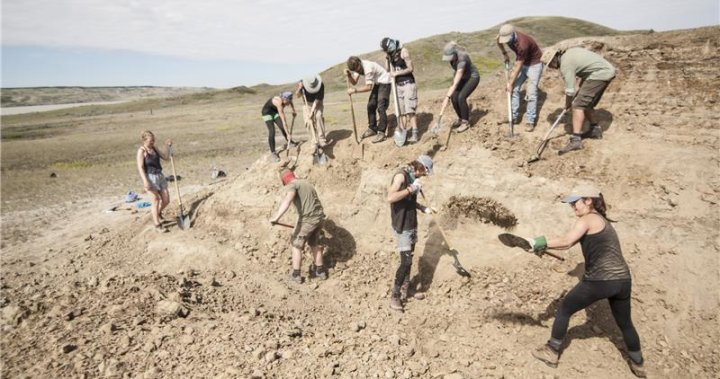While you might think of places like Drumheller, Alta., as the centre of the dinosaur world, Saskatchewan might have a lot more to offer than you might think.
Recently, paleontologists from McGill University discovered Saskatchewan’s first Centrosaurus.
Centrosaurus was a herbivorous dinosaur with one horn on its snout and spines around the back of its neck frill.
“We found fragments of the frill that have horns shaped like hooks and those are distinctive of that species,” Alexandre Demers-Potvin, a PhD, McGill University palaeobiologist said.
“It’s part of a group of dinosaurs called Ceratopsia. And that pretty much includes all the dinosaurs that had horns on their heads. So, think of anything like triceratops.”
McGill University students and paleontologists have found Saskatchewan’s first confirmed fossil specimens of centrosaurus.
Courtesy of Katherine Dumas
As part of the discovery, researchers also uncovered a unique ecosystem at the Lake Diefenbaker Bonebed in Saskatchewan Landing Provincial Park.
Demers-Potvin said it revealed an environment unlike any previously documented in Canada.

Get daily National news
Get the day’s top news, political, economic, and current affairs headlines, delivered to your inbox once a day.
According to University of Saskatchewan adjunct professor Dr. Emily L. Bamforth, the finding has changed the way we think about the ecosystem found in Saskatchewan 75 million years ago.
She said it is the first look at a coastal habitat, unlike anything else in Canada.
“Saskatchewan was actually beachfront property at that time, which is kind of hard to imagine today,” Bamforth explained. “But that’s kind of where our dinosaurs, both in Alberta and Saskatchewan were living. Kind of in this coastal floodplain beside the sea.”
The Centrosaurus fossil was transported to the Royal Saskatchewan Museum in Regina for further research, and one day it could be on display.
“When we get one of these museum specimens it’s not the end of the story,” Dr. Ryan McKellar, the Royal Saskatchewan Museum curator of paleontology said. “They then get used for things like chemical analysis or finding growth rings in the bone to figure out how old these dinosaurs were.”
McKellar hopes discoveries like this put Saskatchewan on the map.
“Finds like this and the fieldwork that goes into them draw a lot of paleo students to the province and also other researchers. We have people that come from all over the world to work on the rocks in Saskatchewan.”
© 2024 Global News, a division of Corus Entertainment Inc.
First-of-its-kind dinosaur fossil reveals look at Saskatchewan 75 million years ago





